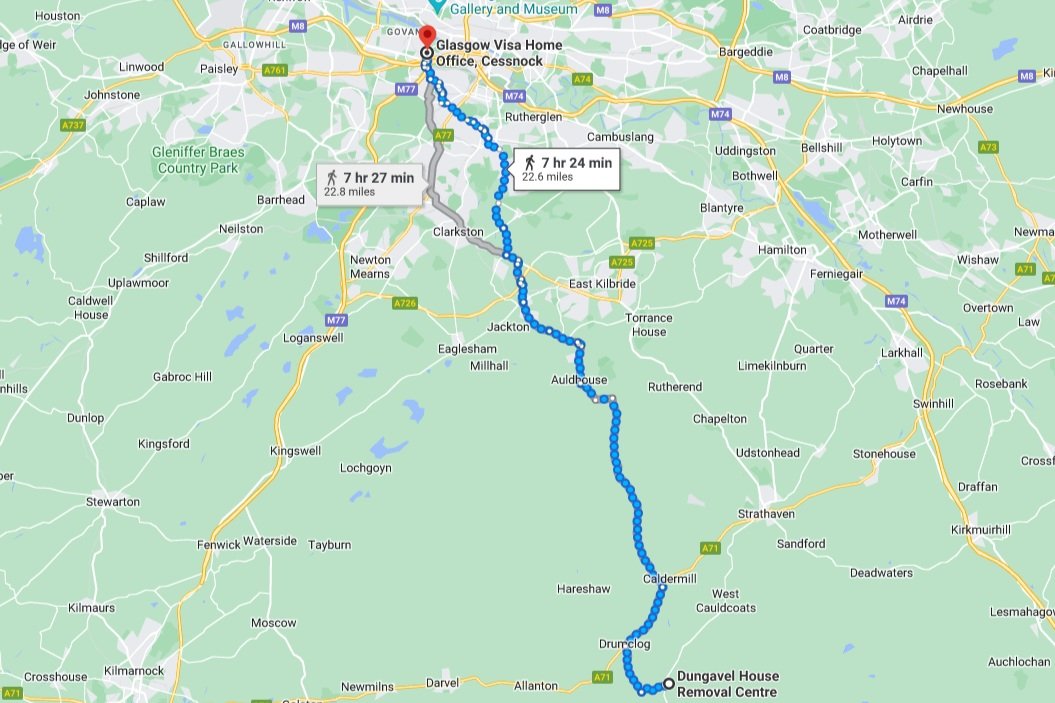Amber
In this guest blog, artists Paria Goodarzi and Fancisco Llinas-Casas, describe their walk from Dungavel to the Home Office in Brand Street. An artistic response to the 70th year of the United Nations Refugee Convention.
We used the 23-mile walk to question whether this anniversary is a time to celebrate or to protest; particularly against the backdrop of UK government not meeting its obligations under the convention.
As part of our performance, we wore engraved mirrors on our backs, responding to ideas of social and national identity, freedom of movement and underrepresentation.
We have ourselves walked this path before, and this action was a literal and metaphoric reflection of our journeys, stories of displacement and the bureaucratic process of the British citizenship.
We live in a democratic country, but we have no freedom. We live in a democracy, but we struggle with migration and the policies and systems around it. So we performed this walk as a monumental action; aiming for people, now and in the future, to wake up and acknowledge the dehumanisation of migrants at the hands of political structures.
The aim of the UN Refugee Convention was to guarantee freedom and safety to people seeking asylum but recently, with the Home Office’s hostile immigration policies, we are concerned the terms of the Convention might not be met.
The name of our piece, Amber, responds to the situation of uncertainty that many of us live due to such hostile environment. The state of liminality or in-betweenness in which asylum seekers find themselves; often resulting in situations like the one experienced in Kenmure Street, Pollokshields.
We planned to set off from Dungavel at 6am and walk together for the first part of our journey. As we were preparing ourselves outside the detention centre, we were pushed to move away from the parking space by security guards. This marked the tone of tension with which our walked started.
As we walked away from Dungavel, we wondered why people, who moved here thinking they had arrived at the promised land and whose only crime was to seek asylum, are put in this place. The walk was an emotional experience and a chance for reflection - literal reflection of the landscape in the mirrors and a thoughtful reflection on the experience of movement and migration. Similarly, it was an act of documentation, a recording of our present political and social flaws for what we hope will be a better the future.
Many metaphors became apparent as we walked, even some we didn't think of when we were developing the work. Such as it being cold, because it was colder than we thought, which reminded us of how unprepared we were when we moved here. We wanted to travel as light as possible because we knew how long a journey we had ahead of us.
The moment of taking separate ways arrived, without doubt this was a moment of anxiety caused by the proximity to the city, the traffic and the thought of being alone for the next section. Around 2pm we parted ways and walked for almost 2 hours only with the company of our own thoughts.
After walking alone, meeting back in Queen’s Park and seeing people gathered there to support us, was very emotional for both of us. At that point, we had been walking for more than nine hours and the feeling of exhaustion mixed with sentiments of joy, gratitude and achievement. Before continuing to Brand Street, we tied white ribbons to a tree planted by Scottish Refugee Council; an action that we repeated at many stages of our walk as a celebration of our stories and a trace of our protest.
We pushed our bodies during the last hour of our walk and with the support of the audience, we made it to the Home Office building. We shared our thoughts with people walking alongside us and marked our arrival by a collective action of tying white ribbons to the Home Office fence.
Our arrival was a movement of deep reflection for us. Before our eyes, the Home Office building represented not only the other end of Amber’s path but also the other side of the British migration system. In one day, we saw the building where refugee rights are denied by removal, and the building where the potential of obtaining refuge and Home reside.
It's been 70 years of the UN Refugee Convention and the values and rights that are enshrined in the Convention are still not secure and are subject to debate. That says a lot about what we have achieved and what we have not achieved. It is devastating to see places like Dungavel, where space and resources are invested into the dehumanisation of people who are only seeking safety.
If we can bring this question into people's houses for at least a couple of minutes and prompt them to ask themselves ‘what is our role in all of this?’, that would mean our protest was a success.

